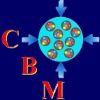INR RAS - international collaborations
Fundamental nuclear physics

Project BGO-OD (University of Bonn , Germany). Study of the nucleon spin structure using a beam of polarized photons with energies up to 2.5 GeV and polarized targets.
The experiment status is the apparatus development and test measurements. The main goal is to study photonuclear reactions using a bremsstrahlung beam of tagged photons with energies up to 2500 MeV at synchrotron ELSA. From other experiments the BGO-OD facility is characterized by the presence of a magnetic spectrometer and a wide aperture detector that will allow study in detail the photoproduction of heavy and strange mesons on nucleons and nuclei.
Participation of the Russian side is in the planning and preparation of the experiments , the data taking and analysis of the experimental data.

Photoproduction of heavy mesons, experiment GRALL
(Laboratoire de Physique Subatomique et de Cosmologie, Grenoble;
Institut de Physique Nucle'aire, Orsay, France).
Study of static, dynamical (nucleon resonances), spin nucleon structure using the monochromatic polarized back scattered gamma beam.
Contribution of INR RAS: creation, maintenance work of the electromagnetic shower calorimeter, data handling and data analysis.

Study of nucleon and nuclear structure with real photons.
A2-collaboration - experiments with real photons on MAMI (MAinzer MIcrotron), (Institut fur Kernphysik of the Johannes Gutenberg-Universitut, Mainz, Germany).
Study of dynamical (nucleon resonances), spin structure of nucleons and few nucleon systems using the Bremsstrahlung tagged (polarized and unpolarized) photons. Pioneering experiments with polarized both target and beam.
INR RAS participates in creation and maintenance of targets and detector systems, experiment simulations, data handling and data analysis.

Project ELISe - Electron-Ion scattering in a Storage Ring (eA Collider),
Gesellschaft fur Schwerionenforschung - GSI, Darmstadt, Germany.
Study of exotic nuclei far from the stability region by electron scattering in the colliding electron - ion beams.
Contribution of INR RAS: simulation and development of the detector system for magnetic spectrometer and luminosity monitor, experiment is planned to start in 2015.

High Acceptance Di-Electron Spectrometer - HADES
( Gesellschaft fur Schwerionenforschung - GSI, Darmstadt, Germany).
It's main research activity is focused to the investigation of in medium properties of light vector mesons in dense nuclear matter. Despite that the present knowledge of the properties of light vectors mesons in vacuum is well investigated, a set of theoretical models predict that properties of light vector mesons surrounded by strong interacting matter might be noticebly altered.
INR's Laboratory of Meson-Nuclear Interactions collaborated in manufacturing of the TOFINO detector. In addition, expluatation of the TOFINO and partially of the Forward Wall detectors is driven by INR RAS.

Presently, preparation to the CBM experiment which will be focused to studies of compressed baryon matter in GSI, Darmstadt, is one of our current investigation projects related to future plans. The interest to the CBM experiment is related to the plan for upgrade of the GSI accelerator complex up to 20-40 GeV/nucleon. This will allow investigations in some specific region of compression and baryon density which has potential for the discovery of a new phase of nuclear matter.

Theoretical collaboration between INR RAS and Frankfurt Institute for Advanced Studies (FIAS, Germany) is devoted to improvement of description of nuclear reactions at low, intermediate and high energies. We develop dynamical models, like INC (Intra-Nuclear Cascade), UrQMD (Ultra-relativistic Quantum Molecular Dynamics), relativistic electromagnetic dissociation model RELDIS, as well as statistical models, like evaporation, fission, Fermi-break-up, and multifragmentation (all included into statistical multifragmentation model - SMM). Special attention is paid to promising peripheral reactions with relativistic heavy ions leading to production of new isotopes, neutron-rich and exotic nuclei important for fundamental knowledge and practical applications. The reaction of multifragmentation gives a chance to investigate Equation of State (EoS) of nuclear matter that is actual for astrophysical objects as neutron stars.
WWW.INR.RU 2001 © webmasters